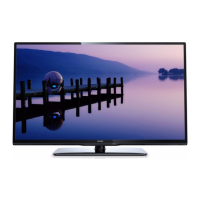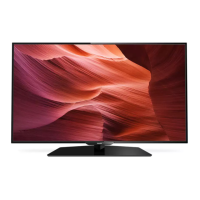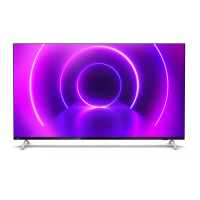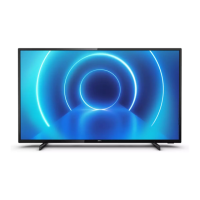Do you have a question about the Philips PFL3xx8H/T and is the answer not in the manual?
General safety, electric shock, fire, damage risks, and child injury prevention.
Risks related to batteries, overheating, power cords, and hearing damage from headphones.
Handling the TV in low temperatures and health warnings for 3D viewing.
Instructions for cleaning the TV screen and preventing damage from stationary images.
Guidelines for cleaning and maintaining 3D glasses to ensure proper function and prevent damage.
Advice on positioning the TV for optimal viewing distance, eye level, and sound settings.
Information on the TV's security slot for theft prevention.
Copyright details, manufacturer information, and disclaimers on specifications and product use.
Details on warranty coverage, repairs, usage guidelines, and conditions that may void the warranty.
Explanation of pixel behavior and what constitutes a structural property versus a malfunction.
Statement of compliance with relevant EU directives for safety and electromagnetic compatibility.
Philips' commitment to health and safety regarding electromagnetic fields (EMF).
Offer to provide source code for open-source software packages used in the product.
Listing of registered trademarks for various technologies and software used in the TV.
Description of energy-saving features accessible via the Green button on the remote.
Guidance on responsible disposal of old products and recycling of materials.
Information on battery disposal according to European directives for environmental protection.
Accessing support, FAQs, manual downloads, and online chat on the Philips support website.
Links to an online connectivity guide and the Philips TV community forum.
How to contact Philips TV Consumer Care for support, including model and serial number.
Overview of TV buttons, standby LED, and remote control sensor.
Explanation of remote control buttons for TV operation and menu navigation.
Explanation of buttons like Back, Channel, Volume, Mute, Color, Subtitle, and Text.
How to control HDMI-CEC devices with one remote after enabling EasyLink.
Instructions for switching the TV on/off, standby mode, and adjusting volume.
How to adjust TV volume, mute sound, and set headphone volume.
How to switch channels using +/- buttons or numeric buttons.
Creating, displaying, and reordering lists of favorite TV channels.
Options to filter channels by type and rename channels in the list.
How to switch between antenna and cable connections for TV channels.
How to prevent unauthorized access to channels by locking them with a PIN code.
Instructions for accessing and listening to digital radio channels.
Steps to select a connected device using SOURCE or Home menu.
How to choose predefined picture and sound styles like Vivid, Movie, Music.
How to change the picture format (Auto, Super zoom, Wide screen) based on content.
Details on Super zoom, Movie expand, Wide screen, Unscaled, and 4:3 formats.
How to view channel schedules and synopses, and conditions for viewing.
Options to update, change day, search by genre, or view reminders in the programme guide.
Information on what is needed for 3D viewing, including health warnings and glasses.
Recommendations for seating distance and eye level for optimal 3D viewing.
How the TV detects 3D signals and prompts for glasses, with response options.
How to select 3D content from Blu-ray discs or TV programs.
How to adjust the 3D format for overlapping images due to missing signal tags.
Instructions on converting 2D content to 3D and adjusting 3D depth.
How to play videos, photos, and music from a USB storage device.
Connecting a USB device and selecting files from the content browser.
Options for video playback including subtitles, audio language, repeat, and info display.
Options for music playback including repeat, shuffle, and song information display.
How to view pictures, start slideshows, and control playback options.
Options to adjust slideshow frequency, transitions, repeat, shuffle, rotate, and show info.
How to select pages, navigate, and use teletext options like freeze and dual screen.
How to select teletext languages and navigate through subpages.
How to display the TV clock and change its mode (automatic/manual).
How to set the time zone and daylight saving time if available.
How to manually set the date and time on the TV.
How to set the TV to switch to standby after a specified time.
How to set/change child lock code, lock channels, and set parental ratings.
How to adjust picture settings like style, contrast, brightness, colour, and sharpness.
Accessing advanced picture settings like gamma, tint, video contrast, and screen brightness.
How to change picture format, size, and position.
How to adjust sound settings like style, bass, treble, surround mode, and headphone volume.
Settings for audio experience, auto volume, TV speakers, clear sound, and audio output format.
How to select audio format (Mono/Stereo) for analogue channels.
How to reset all picture and sound settings to factory defaults.
How to run a full channel installation to update language, country, and channels.
Steps to initiate channel search and installation for antenna or cable.
How to search and store analogue TV channels one by one.
How to search and store digital channels one by one using frequency.
How to fine-tune analogue channels for better reception quality.
Information about automatic and manual updates of the TV channel list.
How to disable messages displayed at startup when a channel update is performed.
How to turn off automatic channel updates in the installation menu.
Steps to manually update TV channels via the setup menu.
What is needed to copy channel lists between Philips TVs (country, year, DVB type).
Procedure to copy the channel list from a TV to a USB storage device.
How to copy a channel list to a second TV, with or without pre-installed channels.
How to ensure the country setting matches for copying channel lists.
How to select the desired language for the TV menu interface.
How to select preferred audio and subtitle languages for broadcast content.
How to use the TV demo feature and set the TV to Home mode.
How to check the current software version installed on the TV.
Overview of methods for updating TV software: USB and digital broadcast.
Detailed steps and requirements for downloading and installing software updates using a USB drive.
Cautionary notes and steps for performing a TV software upgrade using a USB drive.
How to update software received through digital broadcasts or save update files for later.
How to reset picture, sound settings, and reinstall channels to factory defaults.
Guidance on cable quality and choosing the highest quality connection for devices.
Details on HDMI, SCART, and VGA connections, their capabilities and limitations.
Diagram showing how to connect the antenna to the TV's antenna input.
Diagram showing how to connect a Blu-ray or DVD disc player to the TV using an HDMI cable.
Diagrams showing connection of a digital TV receiver via antenna, HDMI, or SCART.
Diagrams showing connection of a video recorder via antenna, HDMI, or SCART.
Diagrams for connecting game consoles and home theatre systems via HDMI and optical audio.
Diagrams for connecting home theatre via SCART, and cameras/camcorders via USB/HDMI.
Diagrams showing connection of USB storage devices and computers to the TV.
Diagram for connecting a computer using DVI-HDMI and audio cables.
Steps to select a connected device for viewing using SOURCE or Home menu.
Information on Philips EasyLink for controlling HDMI-CEC devices with the TV remote.
Using HDMI ARC to output TV audio through connected home theatre speakers.
Steps to enable the EasyLink feature in the TV settings.
How to control multiple HDMI-CEC devices using the TV remote, including switching back to TV control.
Explanation of remote buttons used for controlling EasyLink devices (power, play, numeric).
How to select speaker output for HDMI ARC devices and manage TV speakers.
How to switch audio streaming between TV speakers and connected amplifier.
How to watch scrambled digital TV channels using a CAM module.
What is needed for a CAM and how to insert it into the TV's Common Interface slot.
Steps to activate the CAM and select the CAM provider to access services.
Troubleshooting steps for when the TV does not switch on or is unresponsive to controls.
Troubleshooting red blinking standby light and incorrect audio or menu language.
How to override a forgotten child lock code and information on TV software upgrades.
Troubleshooting for installing TV channels, including checking DVB support.
Troubleshooting missing channels, poor reception, and rearranging channel lists.
Troubleshooting no picture, distorted picture, poor quality, or incorrect picture format/position.
Addressing scrambled broadcast pictures and removing the e-sticker banner.
Troubleshooting unstable computer display and poor sound quality.
Troubleshooting HDMI device recognition, sound disruptions, and EasyLink compatibility.
Troubleshooting USB device content not displaying or playing smoothly.
Guidance on contacting Philips for support and warnings against self-repair.
Details on power, reception inputs, panel resolution, and picture enhancement.
List of supported display resolutions for HDMI and VGA computer formats.
List of supported image, audio, video, and subtitle file formats.
Information on supported USB devices and tables of audio/video formats.
Details of rear and side connectors for different TV models.
Display of the software version number for the TV.
| Display Type | LED |
|---|---|
| Aspect Ratio | 16:9 |
| HDMI Ports | 2 |
| USB Ports | 1 |
| Smart TV | No |
| Built-in Wi-Fi | No |
| Screen Size | 32 inches |











